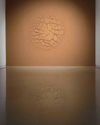On Saturday, the 8th of February, thousands of people witnessed veteran artist Nalini Malani’s multi-panel paintings, Twice upon a time (2014) and All we imagine as light (2017), as well as her series of over fifty animations, Can You hear Me? (2017-2019), projected on a 250-foot façade of Mumbai’s iconic Taj Mahal Tower. The loop ended in a colourful extravaganza featuring a joyful girl jumping in the air, over the entire height of the façade. As the works transported viewers into Malani’s theatrical world layered with literary, mythological and personal referents, the community of individuals that gathered together was arrested in an upward gaze. Malani noted a poignant dialogue she heard between two viewers. One said, “Look how much the city has changed” to which he earned a response, “It is perhaps not the city that has changed, but our way of seeing.”
The historic public display at the Taj was an extension of Malani’s exhibition that celebrated the Goethe Institute/ Max Mueller Bhavan’s 50th anniversary, on view from the 19th of October 2019 to the 2nd of January 2020. There, she juxtaposed her earliest film Dream Houses (1969) with her new animations. These works, among others, also featured in Malani’s exhibition, The Witness curated by Tasneem Zakaria Mehta and Johan Pijnappel at the Dr. Bhau Daji Lad Museum from the 11th of January to the 31st of March. Exhibiting in Mumbai after over a decade, and for the first time since winning the prestigious Joan Miró Prize in 2019, Malani elicits considerations of spatial, historiographical and cultural dimensions of the city.
Denne historien er fra July 2020-utgaven av Art India.
Start din 7-dagers gratis prøveperiode på Magzter GOLD for å få tilgang til tusenvis av utvalgte premiumhistorier og 9000+ magasiner og aviser.
Allerede abonnent ? Logg på
Denne historien er fra July 2020-utgaven av Art India.
Start din 7-dagers gratis prøveperiode på Magzter GOLD for å få tilgang til tusenvis av utvalgte premiumhistorier og 9000+ magasiner og aviser.
Allerede abonnent? Logg på

Parts, Wholes And The Spaces In Between
Sonal Sundararajan introduces Samira Rathod's free-spirited and rebellious explorations in the world of architecture, furniture and design.

"The Fine Art of Going to the Pictures."
Dr. Banerjee in Dr. Kulkarni's Nursing Home at Chemould Prescott Road brings together 26 paintings featuring a series of dramatic scenes from Hindi and Bengali films. In conversation with Abhay Sardesai, artist Atul Dodiya talks about childhood trips to movie halls, painted figures gripped by tension, and the closeness and remoteness of cinematic images.

"To Finally Have Something of Your Own to Mine."
Dayanita Singh is the recipient of the coveted 2022 Hasselblad Award. Keeping the photograph at the centre, she speaks to Shreevatsa Nevatia about books, book objects, photo novels, exhibitions and museums.

OF DIVINE LOSS
Shaurya Kumar explores the relationship between the subject and object of devotion, finds Aranya.

THE PAST AND ITS SHADOWS
Neha Mitra visits two shows and three artists in Mumbai.

FORCE OF NATURE
Alwar Balasubramaniam dwells on absences and ephemeralities in his new work, states Meera Menezes.

SHAPES OF WATER
Devika Sundar's works delineate the murky, malleable boundaries between the human body and the organic world, says Joshua Muyiwa.

INTIMATIONS OF INTIMACY
Sunil Gupta shares his journey with Gautami Reddy.

THE FRACTURED PROSPECT
Nocturnal landscapes as ruins in the making? Adwait Singh looks at Biraaj Dodiya's scenes of loss.

TEETERING BEYOND OUR GRASP
Meera Menezes traces Mahesh Baliga's journey from Moodabidri to London.